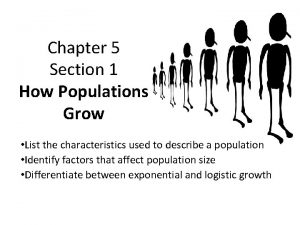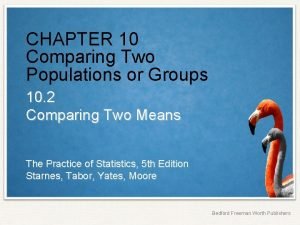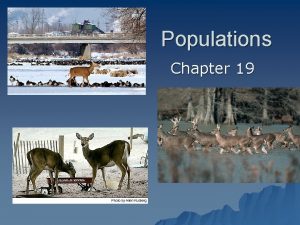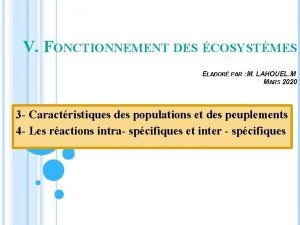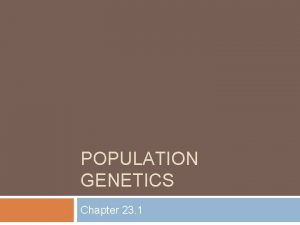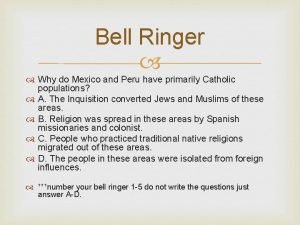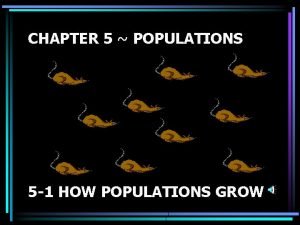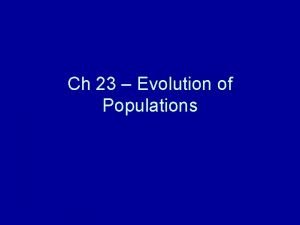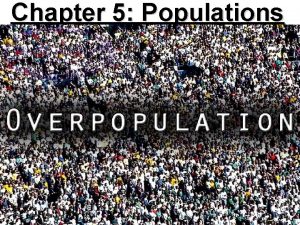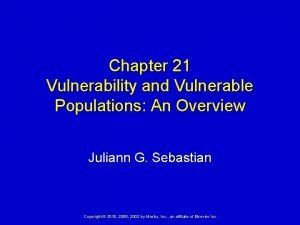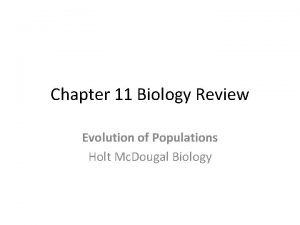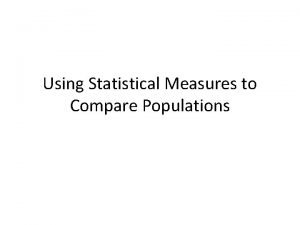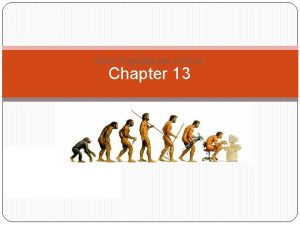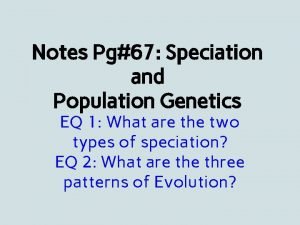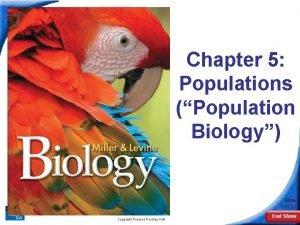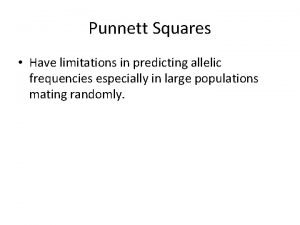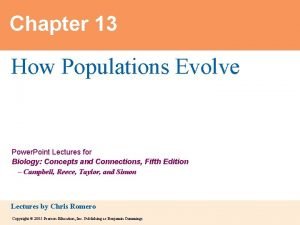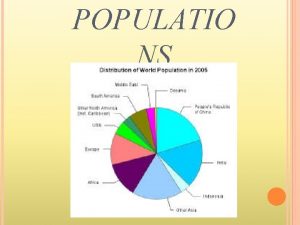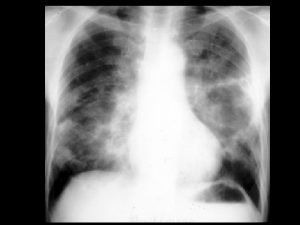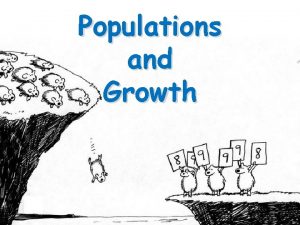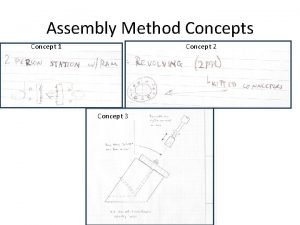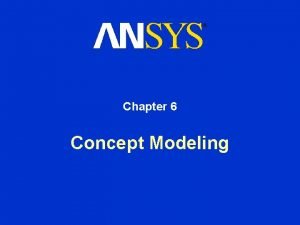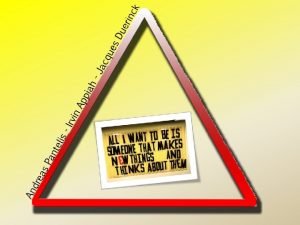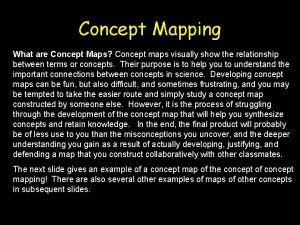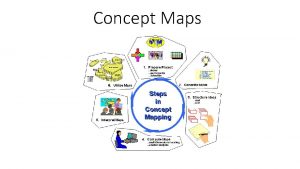43 Populations Concept 43 1 Populations Are Patchy




























- Slides: 28

43 Populations

Concept 43. 1 Populations Are Patchy in Space and Dynamic over Time Population—all the individuals of a species that interact with one another within a given area at a particular time.

Concept 43. 1 Populations Are Patchy in Space and Dynamic over Time Population density—number of individuals per unit of area or volume Population size—total number of individuals in a population Counting all individuals is usually not feasible; ecologists often measure density, then multiply by the area occupied by the population to get population size.

Concept 43. 1 Populations Are Patchy in Space and Dynamic over Time Abundance varies on several spatial scales. Geographic range—region in which a species is found Habitat patches are “islands” of suitable habitat separated by areas of unsuitable habitat.

Figure 43. 1 Species Are Patchily Distributed on Several Spatial Scales (Part 1)

Figure 43. 2 Population Densities Are Dynamic and Interconnected

Concept 43. 2 Births Increase and Deaths Decrease Population Size Change in population size depends on the number of births and deaths over a given time. “Birth–death” or BD model of population change:

Concept 43. 2 Births Increase and Deaths Decrease Population Size Per capita birth rate (b)—number of offspring an average individual produces Per capita death rate (d)—average individual’s chance of dying Per capita growth rate (r) = (b – d) = average individual’s contribution to total population growth rate

Concept 43. 3 Life Histories Determine Population Growth Rates Life history—time course of growth and development, reproduction, and death during an average individual’s life Life histories are quantitative descriptions of life cycles. Example: the life cycle of the black-legged tick.

Figure 43. 3 Life History of the Black-Legged Tick

Concept 43. 3 Life Histories Determine Population Growth Rates Individual organisms require resources (materials and energy) and physical conditions they can tolerate. Rate at which an organism can acquire resources increases with the availability of the resources. Examples: photosynthetic rate increases with sunlight intensity, or an animal’s rate of food intake increases with the density of food.

Figure 43. 4 Resource Acquisition Increases with Resource Availability (Part 1)

Figure 43. 4 Resource Acquisition Increases with Resource Availability (Part 2)

Concept 43. 4 Populations Grow Multiplicatively, but Not for Long Populations do not grow multiplicatively (exponentially) for very long. Growth slows and reaches a more or less steady size:

Concept 43. 4 Populations Grow Multiplicatively, but Not for Long r decreases as the population becomes more crowded; r is density dependent. As the population grows and becomes more crowded, birth rates tend to decrease and death rates tend to increase. When r = 0, the population size stops changing— it reaches an equilibrium size called carrying capacity, or K.

Figure 43. 8 Per Capita Growth Rate Decreases with Population Density (Part 1)

Concept 43. 4 Populations Grow Multiplicatively, but Not for Long The human population is unique. It has grown at an ever-faster per capita rate, as indicated by steadily decreasing doubling times. Technological advances have raised carrying capacity by increasing food production and improving health.

Figure 43. 9 Human Population Growth (Part 1)

Figure 43. 9 Human Population Growth (Part 2)

Concept 43. 4 Populations Grow Multiplicatively, but Not for Long Many believe that the human population has now overshot its carrying capacity for two reasons: • Technological advances and agriculture have depended on fossil fuels, a finite resource. • Climate change and ecosystem degradation have been a consequence of 20 th century population expansion.

Figure 43. 10 A Metapopulation Has Many Subpopulations

Concept 43. 6 Ecology Provides Tools for Managing Populations Understanding life history strategies can be useful in managing other species. Fisheries: Black rockfish grow throughout their life. The number of eggs a female produces is proportional to her size. Older, larger females also produce eggs with oil droplets that give the larvae a head start on growth.

Concept 43. 6 Ecology Provides Tools for Managing Populations Fishermen prefer to catch big fish. Intense fishing reduced the average of female rockfish from 9. 5 to 6. 5 years. These younger females were smaller, produced fewer eggs, and larvae didn’t survive as well. Management may require no-fishing zones where some females can mature and reproduce.

Concept 43. 6 Ecology Provides Tools for Managing Populations Reducing disease risk: The black-legged tick’s life history indicates that success of larvae in obtaining a blood meal has greatest impact on the abundance of nymphs. Thus, controlling the abundance of rodents that are hosts for the larvae is more effective in reducing tick populations than controlling the abundance of deer, the hosts for adults.

Concept 43. 6 Ecology Provides Tools for Managing Populations Conserving endangered species: Larvae of the endangered Edith’s checkerspot butterfly feed on two plant species found only on serpentine soils. The two plant species are being suppressed by invasive non-native grasses. Grazing by cattle can control the invasive grasses.

Concept 43. 6 Ecology Provides Tools for Managing Populations Conservation plans begin with inventories of habitat and potential risks to the habitat. Largest patches can potentially have the largest populations and are given priorty. Quality (carrying capacity) of the patches is evaluated; ways to restore or maintain quality are developed. Ability of the organism to disperse between patches is evaluated.

Concept 43. 6 Ecology Provides Tools for Managing Populations For some species, a continuous corridor of habitat is needed to connect subpopulations and allow dispersal. Dispersal corridors can be created by maintaining vegetation along roadsides, fence lines, or streams, or building bridges or underpasses that allow individuals to avoid roads or other barriers.

Figure 43. 12 A Corridor for Large Mammals
 Insidan region jh
Insidan region jh Perbedaan pemasaran dan penjualan
Perbedaan pemasaran dan penjualan Ideal self example
Ideal self example 5-1 how populations grow
5-1 how populations grow Chapter 10 comparing two populations or groups
Chapter 10 comparing two populations or groups Complex patient populations
Complex patient populations Section 19-1 understanding populations answer key
Section 19-1 understanding populations answer key Dynamique des populations
Dynamique des populations Section 16-1 genes and variation
Section 16-1 genes and variation Section 5-1 how populations grow answer key
Section 5-1 how populations grow answer key Genetic drift in small populations
Genetic drift in small populations A biologist discovers two populations of wolf spiders
A biologist discovers two populations of wolf spiders Edward jenner’s innovation helped to
Edward jenner’s innovation helped to 5-1 how populations grow
5-1 how populations grow Why are populations the smallest unit of evolution
Why are populations the smallest unit of evolution Section 5-1 how populations grow
Section 5-1 how populations grow Chapter 16 evolution of populations vocabulary review
Chapter 16 evolution of populations vocabulary review Chapter 21 vulnerability and vulnerable populations
Chapter 21 vulnerability and vulnerable populations Evolution of populations section 11 review
Evolution of populations section 11 review Using statistical measures to compare populations
Using statistical measures to compare populations Chapter 13 how populations evolve test
Chapter 13 how populations evolve test Kar 5
Kar 5 Genetic drift
Genetic drift Section 5-1 how populations grow
Section 5-1 how populations grow Limitations of using a punnett square
Limitations of using a punnett square Chapter 23: the evolution of populations
Chapter 23: the evolution of populations 5-1 how populations grow
5-1 how populations grow Chapter 13 how populations evolve
Chapter 13 how populations evolve Individuals don't evolve populations do
Individuals don't evolve populations do



